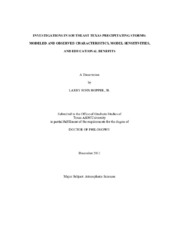| dc.description.abstract | This dissertation establishes a precipitation climatology for common storm types and structures in southeast Texas, investigating diurnal, seasonal, and interannual rainfall variations in addition to climatological differences in raindrop size distributions and storm divergence profiles. Divergence profiles observed by an S-band, Doppler radar are compared to ensemble simulations of ten precipitating systems occurring in warm season, weakly baroclinic, and strongly baroclinic environments. Eight triply-nested mesoscale model simulations are conducted for each case using single- and double- moment microphysics with four convective treatments (i.e., two convective parameterizations and explicit vs. parameterized convection at 9 km). Observed and simulated radar reflectivities are objectively separated into convective, stratiform, and non-precipitating anvil columns and comparisons are made between ensemble mean echo coverages and levels of non-divergence (LNDs). In both the model and observations, storms occurring in less baroclinic environments have more convective rain area, less stratiform rain area, and more elevated divergence profiles.
The model and observations agree best for well-organized, leading-line trailing stratiform systems. Excessive convective rain area and elevated LNDs are simulated for several less organized cases. Simulations parameterizing convection on the intermediate grid produced less elevated divergence profiles with smaller magnitudes compared to their explicit counterparts. In one warm season case, double-moment microphysics generated lower LNDs associated with variations in convective intensity and depth, detraining less ice to anvil and stratiform regions at midlevels relative to a single-moment scheme. Similarly, mesoscale convective vortex simulations employing an ensemble-based versus a single-closure convective parameterization produced the least elevated heating structures (closer to observed) resulting in the weakest midlevel vortices.
Finally, this dissertation is unique in that some of the data collection and a portion of the analysis involved 95 undergraduates in a five-year research and education program, the Student Operational ADRAD Project (SOAP). In addition to documenting the program's structure and implementation, student-reported experiences, confidence, and interest in performing SOAP tasks are also analyzed. Students participating in SOAP for multiple years were significantly more confident in performing SOAP tasks, more likely to obtain science or meteorology-related employment upon graduation, and more likely to matriculate to graduate programs, suggesting programs like SOAP have a strong influence on students' career outcomes and self-efficacy. | en |


